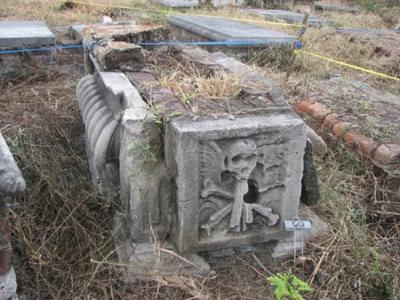
Korah (קֹרַח – Korah)
Numbers 16:1 – 18:32 & I Samuel 11:14 – 12:22
Korah, Dathan, and Abiram are swallowed up for challenging the legitimacy of Moses and Aaron, while the 250 other rebels, who offered unauthorized incense, are consumed by divine fire. To prevent further dissent, Moses asks each tribal leader to place his staff in the sanctuary; only Aaron’s staff buds, blossoms, and produces almonds — an unmistakable sign of divine choice. In the haftarah, the prophet Samuel, who is also challenged, reminds the people that God is Israel’s only true leader.
Numbers 17:23
וַיְהִי מִמָּחֳרָת, וַיָּבֹא מֹשֶׁה אֶל-אֹהֶל הָעֵדוּת, וְהִנֵּה פָּרַח מַטֵּה-אַהֲרֹן, לְבֵית לֵוִי; וַיֹּצֵא פֶרַח וַיָּצֵץ צִיץ, וַיִּגְמֹל שְׁקֵדִים
And it came to pass on the morrow, that Moses went into the Tent of the Testimony; and behold, the rod of Aaron for the house of Levi had budded, and brought forth buds, and bloomed blossoms, and yielded almonds.
In the time of the Second Temple, Magdala — or in Aramaic Migdal Nunaya, “Tower of the Fish” — was a prosperous Jewish city on the western shore of the Sea of Galilee. It had up to 40,000 inhabitants, with a market, ritual baths, a fish-salting industry, and several synagogues. One of these yielded the famous Magdala Stone, adorned with symbols of the Jerusalem Temple: a menorah, jars, columns… and, on its upper face, a floral arrangement that some archaeologists interpret as stylized almond blossoms.

In recent excavations, a bronze incense shovel was found in a room adjoining the prayer hall. This utensil, mentioned in the Torah (Exodus 27:3), was used to scoop embers for the censers.
The modern locality of Migdal was founded in 1910 by Russian Jewish pioneers from the Hovevei Tsion movement[1]. Among the founders were notable figures such as Joseph Trumpeldor[2] and Yossef Haim Brenner[3]. They established an agricultural training farm called Ahuzat Moskva – “Moscow Estate” – to train Jewish farmers.
[1] Hovevei Tsion – Lovers of Zion: a proto-Zionist movement founded in 1881 in Russia, aimed at promoting Jewish settlement in the Land of Israel.
[2] Joseph Trumpeldor (1880–1920): Zionist hero, Russian army veteran, co-founder with Ze’ev Jabotinsky (1880–1940, militant Zionist leader advocating for a strong Jewish state in the Land of Israel) and Nahum Sokolow (1859–1936, writer, politician, and Zionist diplomat) of the Zion Mule Corps (a voluntary Jewish muleteer unit that supported the British Army during the 1915 Gallipoli campaign, seen as a precursor to the Jewish Legion). He died defending Tel Hai, a Jewish outpost in Mandatory Palestine, during an Arab tribal attack in 1920.
[3] Yossef Haim Brenner (1881–1921): major Hebrew writer and pioneer of modern Hebrew literature, assassinated on May 2, 1921, in Jaffa during anti-Jewish riots by Arab assailants, alongside Zionist activists Dr. Yitzhak Vitkin, Dr. Yosef Luria, Avraham Yesod, and Moshe Feinstein, a prominent community leader. They were all buried together in the Trumpeldor Cemetery in Tel Aviv.











